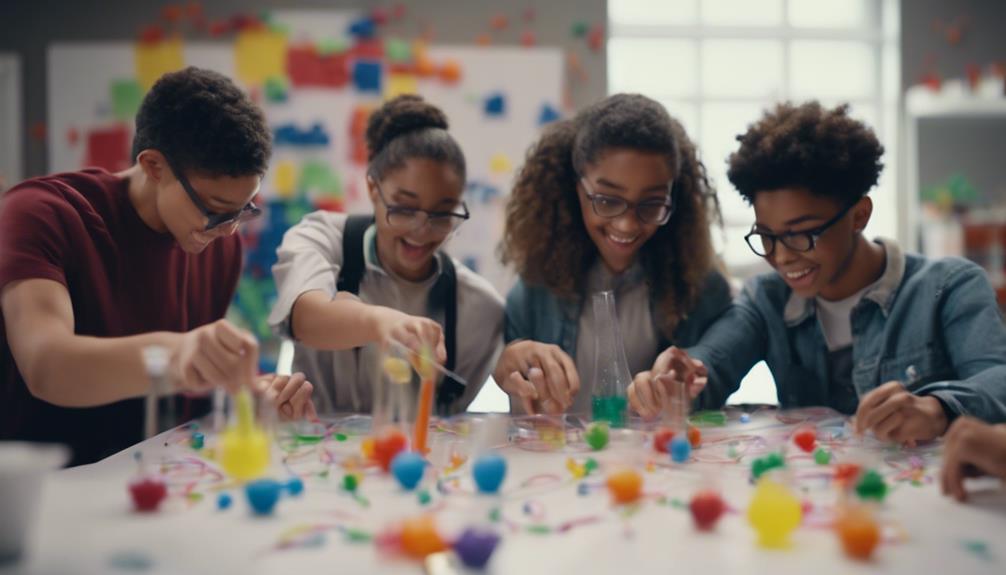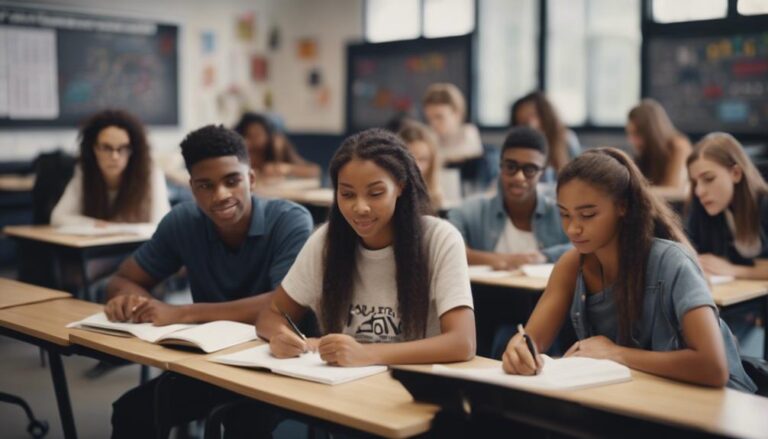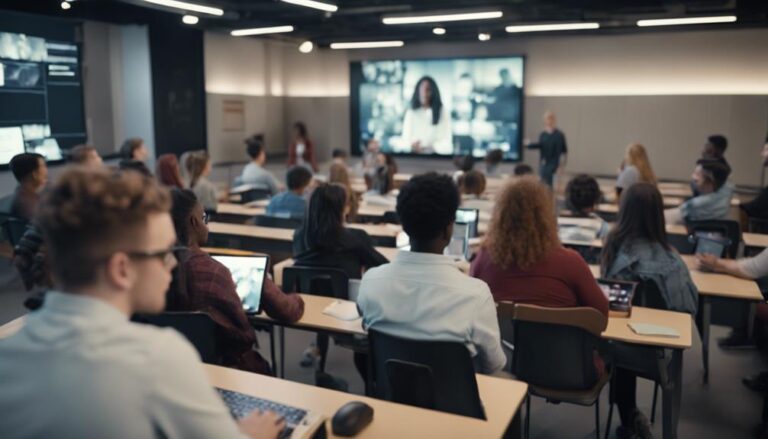Creating Engaging Learning Experiences: The Power of Interactive Activities and Games
Immerse yourself in interactive activities and games that transform learning. Boost engagement, critical thinking, and problem-solving skills. Enhance visual engagement by 30% with multimedia. Collaborate, communicate, and grow in diverse learning styles. Receive real-time feedback for progress and understanding. Prompt responses elevate engagement and understanding. Design SMART learning objectives for success. Cater to all preferences for inclusive learning. Use gamification for improved memory retention. Encourage critical thinking with puzzles and scenarios. Engage in a world of interactive learning experiences that spark curiosity and growth. Embrace the power of games in education for a dynamic and enriching journey.
Benefits of Interactive Learning
How can interactive learning revolutionise traditional education methods and benefit students in modern classrooms?
By focusing on student motivation and hands-on learning, interactive learning brings a new dimension to education. Students are more engaged and motivated when they actively participate in their learning process, leading to improved critical thinking and problem-solving skills. Through interactive activities that incorporate game elements such as rewards and challenges, students are encouraged to take a hands-on approach to learning, further enhancing their understanding of various subjects.
Interactive learning not only boosts academic performance and test scores but also revolutionises the way students interact with educational content. By integrating play-based learning into the curriculum, students develop creativity, critical thinking, collaboration, and diverse skill sets. Whether it's through interactive apps for language learning or games that enhance mathematics education, interactive learning provides a dynamic and engaging learning experience that nurtures a love for learning in students.
Enhancing Student Engagement Through Games
Imagine this: game-based learning benefits that skyrocket student engagement levels, and interactive challenges that leave a lasting impact on your educational journey.
By immersing yourself in these interactive activities, you're not only boosting your participation and motivation by up to 70%, but also enhancing critical thinking skills by 30%.
The key lies in embracing these games as tools to elevate your learning experience and performance in assessments.
Benefits of Learning Through Games
Enhancing student engagement through interactive games greatly enhances learning outcomes and participation rates. Gamified assessments provide immediate feedback, making the learning process dynamic and engaging.
Interactive simulations immerse students in virtual scenarios, enhancing critical thinking and decision-making skills. By integrating game-based learning, students experience an increase in engagement of up to 80% compared to traditional methods. Retention rates also improve by 12%, demonstrating the effectiveness of this approach.
Additionally, students demonstrate a 20% increase in motivation and participation, resulting in a 25% improvement in academic performance. Problem-solving skills receive a significant 15% boost through game-based activities, highlighting the many benefits of incorporating interactive games into the educational curriculum.
Interactive Challenges Impact
Engaging students through interactive challenges in education ignites a passion for learning and fosters a dynamic environment for academic growth. By incorporating interactive challenges into the learning process, you can greatly boost student motivation and create a more engaging classroom experience.
These interactive learning activities not only enhance cognitive development but also encourage critical thinking and problem-solving skills. Research shows that integrating game elements like rewards and challenges into education leads to improved academic performance and test scores.
The impact of interactive activities on student outcomes highlights the effectiveness of gamified approaches in education. Embracing interactive challenges creates a dynamic learning environment that caters to learners of all ages and abilities, ultimately enhancing the overall educational experience.
Incorporating Multimedia for Interactive Experiences
You are about to explore how visual engagement techniques and interactive scenario design can transform your learning experience.
By incorporating multimedia elements, you will be able to immerse yourself in dynamic content that caters to various learning styles.
Get ready to engage with interactive activities that enhance comprehension and retention through multi-sensory experiences.
Visual Engagement Techniques
Incorporating multimedia resources into interactive learning experiences greatly enhances visual engagement, boosting student participation and motivation by up to 30%.
Utilising visual engagement strategies and interactive design techniques through multimedia integration and gamified activities can markedly improve the overall learning experience. By incorporating visual elements like videos and animations, students can increase their information retention by 60%.
Interactive multimedia tools not only enhance student understanding of complex concepts by 50% but also improve critical thinking skills by 40%.
These techniques create an immersive learning environment that encourages active participation and increases student motivation.
Interactive Scenario Design
Immerse yourself in your learning experience through Interactive Scenario Design by seamlessly integrating multimedia elements like videos, images, and audio to create engaging educational simulations. Scenario customisation and learner interaction are key aspects of this approach, allowing you to engage fully in immersive storytelling and receive interactive feedback.
By incorporating multimedia-rich elements into interactive scenarios, you can enhance your engagement and retention of knowledge. These simulations not only replicate real-world situations but also promote critical thinking and problem-solving skills.
Through active participation and diverse learning styles catered to by multimedia integration, interactive scenarios make learning more accessible and effective. Engage in interactive scenario design to elevate your learning journey and make the most out of educational simulations.
Fostering Collaboration in Learning Activities
Fostering collaboration in learning activities cultivates essential skills such as critical thinking and problem-solving, enhancing students' real-world readiness. Engaging in collaborative challenges and interactive teamwork not only promotes communication and teamwork but also encourages peer-to-peer learning and knowledge sharing. By working together on collaborative projects, students are able to tap into their creativity and innovation, making the educational experience more dynamic.
Collaboration in learning activities leads to increased engagement and motivation among students. Through group work, individuals learn to appreciate diverse perspectives and leverage each other's strengths, preparing them for the challenges of the future. Interactive activities provide a platform for students to practice real-world skills in a supportive environment, where they can experiment, make mistakes, and learn from each other. By fostering collaboration, educators create opportunities for students to thrive and develop the necessary skills to succeed in the modern world.
Real-Time Feedback in Interactive Learning
You are about to discover the power of real-time feedback in interactive learning.
Instant assessment benefits, interactive progress updates, and timely response advantages are within your reach.
Embrace the impact of immediate feedback on your learning journey.
Instant Assessment Benefits
Instant assessment in interactive learning revolutionises the educational landscape by providing real-time feedback on student progress and understanding. This innovative approach offers immediate insights and real-time evaluation, allowing educators to tailor their teaching strategies on the spot.
Here are some benefits of instant assessment:
- Enhances active participation and engagement.
- Identifies areas needing additional support promptly.
- Supports prompt clarification of doubts.
- Improves learning outcomes by addressing student needs immediately.
- Allows for quick adjustments in teaching methods based on student responses.
Integrating instant assessment into interactive activities fosters a dynamic learning environment where student needs are met promptly, leading to enhanced educational experiences and improved outcomes.
Interactive Progress Updates
Enhancing the learning experience through real-time feedback in interactive activities provides valuable insights into student progress and engagement. Interactive feedback analysis and student progress tracking enable educators to monitor participation and comprehension instantly.
By receiving immediate intervention strategies and personalised support, students can benefit from tailored assistance based on their performance during interactive tasks. These interactive progress updates not only offer insights into how well students are grasping the material but also serve as motivation for active involvement.
Through real-time feedback, educators can identify areas where students excel or struggle, allowing for timely support to enhance overall learning outcomes. Immediate feedback fosters a dynamic learning environment where students feel supported and encouraged throughout their educational journey.
Advantages of Responding Promptly
In the domain of interactive learning, the immediate feedback provided offers a vital advantage by facilitating timely corrections and reinforcing correct responses. Real-time feedback plays a pivotal role in enhancing the learning experience for students.
Here are some key benefits of timely responses in interactive learning:
- Response Speed: Quick feedback allows for prompt adjustments and improvements.
- Engagement Benefits: Students are more engaged when they receive immediate responses to their actions.
- Active Participation: Real-time feedback encourages active participation and involvement in the learning process.
- Understanding Retention: Timely responses help students better understand and retain key concepts.
- Individualised Instruction: Educators can personalise instruction based on immediate feedback to cater to individual student needs effectively.
Designing Effective Learning Objectives
Crafting effective learning objectives requires a strategic approach that ensures clarity and alignment with instructional design goals. To create impactful objectives, focus on making them specific, measurable, achievable, relevant, and time-bound (SMART). Clear learning outcomes are essential as they serve as a roadmap for instructional design and assessment, providing a guide for both educators and learners. Well-defined objectives help to focus on desired outcomes and guide the learning process effectively.
Aligning learning objectives with instructional activities enhances learner engagement and success. By ensuring that the objectives are closely tied to the instructional design, you can motivate learners and improve the overall effectiveness of the learning experience. Effective assessment strategies play a key role in evaluating the achievement of these objectives and maintaining learner motivation throughout the learning process. Remember, the clearer and more aligned your learning objectives are with instructional design principles, the more impactful your learning experiences will be.
Catering to Diverse Learning Styles
To effectively cater to diverse learning styles, educators can make use of interactive activities and games that offer different engagement opportunities for students. By including interactive elements, you can address the various learning preferences in your classroom, ensuring that all students have a chance to do well.
Here are some key points to remember:
- Interactive activities cater to visual, auditory, kinesthetic, and tactile learning preferences.
- They provide multiple ways for students to get involved with the material based on their individual strengths.
- Hands-on learners can benefit from interactive games that allow them to physically engage with the content.
- Visual learners may excel in activities that present information in a graphical or visually appealing way.
- By providing a range of interactive engagement opportunities, you can create an inclusive learning environment where every student can take part and learn effectively.
Gamification Elements for Improved Retention
Catering to diverse learning styles through interactive activities opens the door to leveraging gamification elements for improved retention. Gamification, with features like points, badges, and leaderboards, has been proven to enhance memory retention in educational environments.
By incorporating rewards and incentives within gamified learning experiences, you can greatly boost information recall among students. Setting clear goals and objectives in gamification activities further contributes to better retention of learning content.
Immediate feedback loops provided through gamification elements play an important role in reinforcing the retention of knowledge and concepts. Additionally, gamified eLearning platforms equipped with progress tracking mechanisms have shown to not only increase retention levels but also elevate overall engagement.
Embracing gamification elements in your teaching approach can lead to improved memory retention and heightened interactive engagement, ultimately creating more impactful learning experiences for your students.
Promoting Critical Thinking Through Activities
Engage students in problem-solving puzzles and decision-making scenarios to enhance critical thinking skills effectively. By incorporating activities that stimulate critical thinking development and group dynamics, you can empower students to navigate complex challenges with confidence.
Utilise problem-solving strategies and interactive simulations to cultivate a culture of active learning and analytical thinking. Encourage students to explore various perspectives, contemplate multiple solutions, and collaborate with their peers to achieve common goals. Here are some key points to contemplate when promoting critical thinking through activities:
- Foster a supportive environment that encourages risk-taking and experimentation.
- Encourage students to question assumptions and think outside the box.
- Provide opportunities for students to practise evaluating evidence and making reasoned judgements.
- Incorporate reflection exercises to help students analyse their thinking processes and identify areas for improvement.
- Utilise group activities to enhance communication skills, promote teamwork, and develop a shared understanding of complex issues.
Adaptive Learning Paths for Personalised Experiences
By tailoring educational paths to individual student needs and preferences, adaptive learning technology revolutionises the personalised learning experience in academia. Personalised instruction is at the core of adaptive learning paths, allowing for tailored feedback and support that caters to each learner's unique requirements.
These paths dynamically adjust the content, pace, and difficulty level of lessons based on the student's progress and performance, ensuring a customised learning journey. Utilising data analytics and algorithms, adaptive learning technology provides targeted instruction that optimises learning outcomes by accommodating different learning styles and abilities.
Research indicates that students engaged in adaptive learning paths show improved levels of engagement, knowledge retention, and academic performance compared to traditional teaching methods. By embracing adaptive learning paths, educators can create a more interactive and impactful learning environment that meets the diverse needs of their students, ultimately leading to enhanced learning experiences and outcomes.

Benjamin Margate is a British biology author, educator and podcaster, leveraging a leveraging a BSc in Biological Sciences from University of Birmingham and over 10 years of expertise creating and curating detailed biology content. His work focuses on providing educational blogs and resources for biology students and facilitating connections with professional tutors. Recognised for his extensive knowledge and commitment to biology education, Benjamin’s contributions have become a cornerstone for learners seeking to enhance their understanding of the subject.




